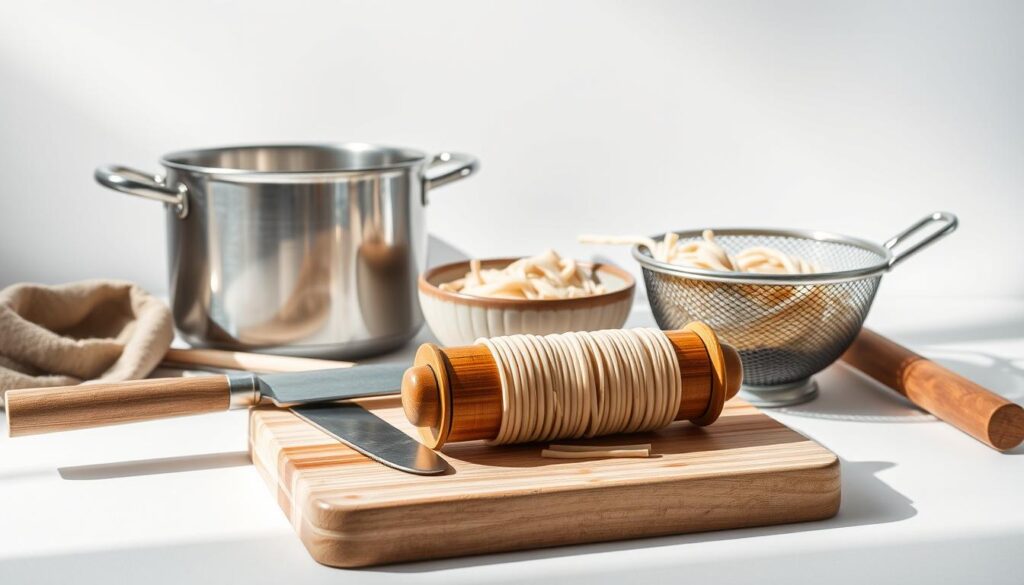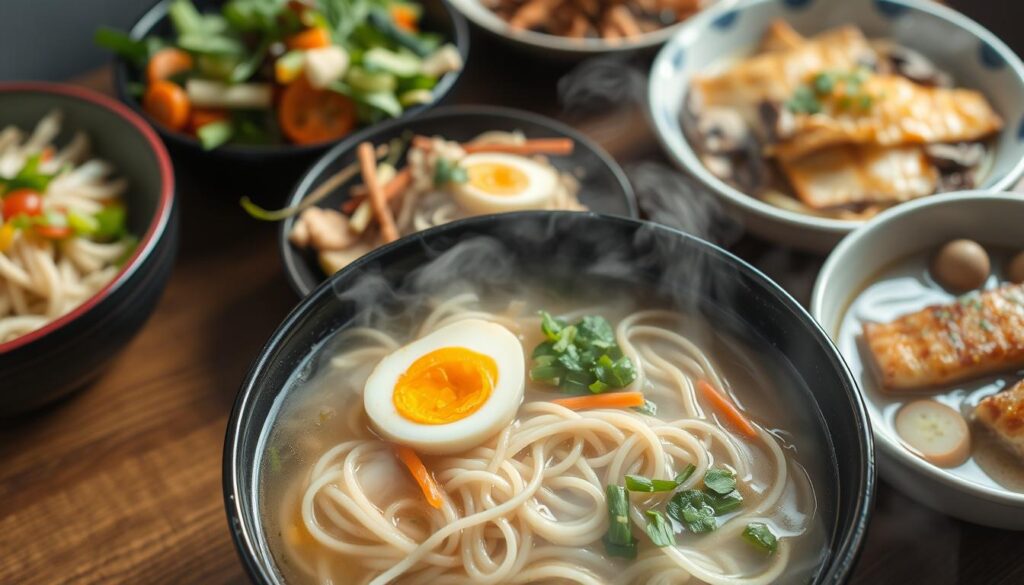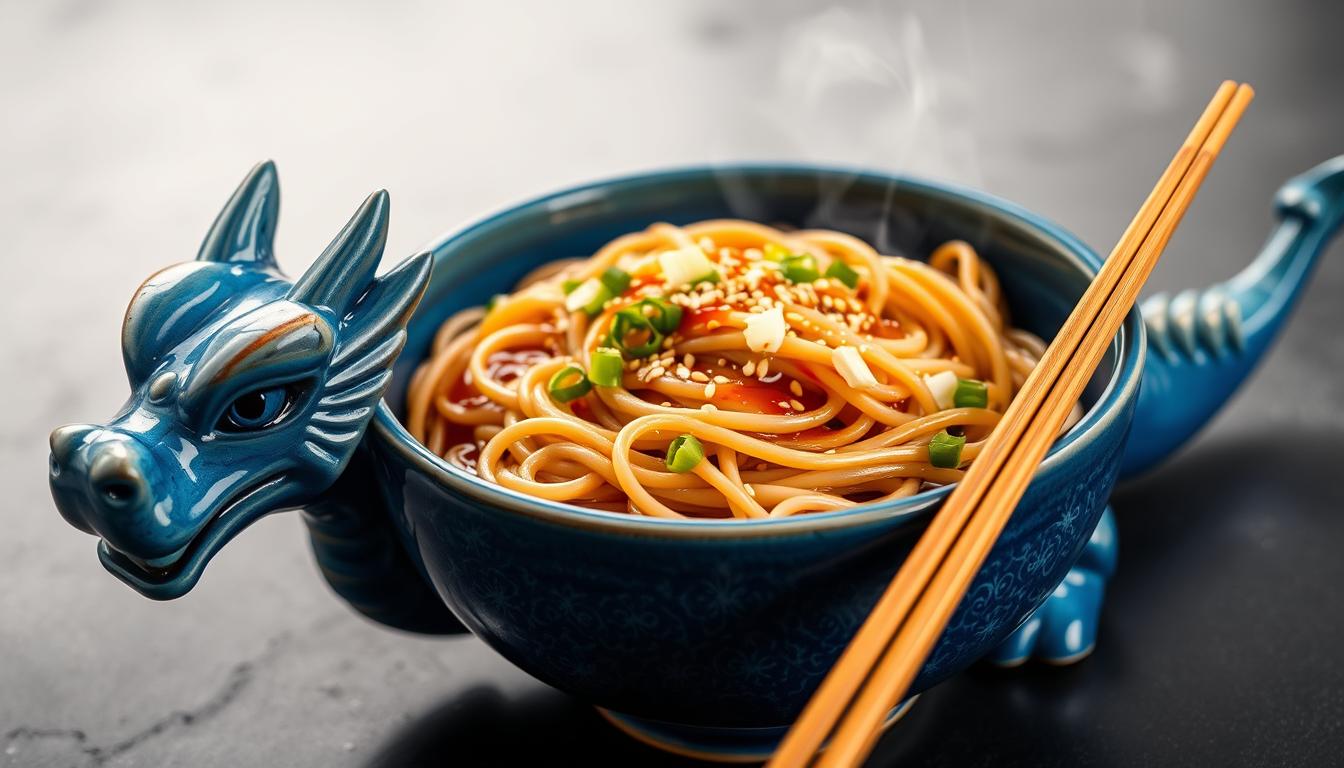Table of Contents
I still remember my first taste of Blue Dragon Soba Noodles. The smell of buckwheat, the noodles’ chew, and the broth’s flavors opened a door to Japanese tradition in my kitchen. Now, I’m excited to share this blue dragon soba noodles recipe with you. It shows that authentic dishes can be simple.
What I love about these noodles is their taste and story. They’re made from premium buckwheat, capturing Japan’s culinary essence. Yet, they’re easy enough for a weeknight meal. This guide will show you how to make them into a simple yet extraordinary dish.
Whether you’re new to Asian cooking or a seasoned chef, these easy soba noodle recipes are for you. You’ll learn to balance flavors, textures, and tradition without making it complicated. By the end, you’ll see why soba has been loved for centuries. And how it can become your favorite comfort food too.
Key Takeaways
- Blue Dragon noodles offer authentic buckwheat flavor and texture.
- Mastering the recipe takes minutes but delivers big flavor rewards.
- Soba adapts to both quick meals and special occasions.
- Health-conscious eaters love its protein and gluten-free options.
- Simple ingredients create complex, satisfying dishes.
What Are Soba Noodles? Understanding the Japanese Classic
Soba noodles are a key part of Japanese food. They are made from buckwheat flour and have a nutty taste. These noodles are firm and unique.
They are more than just food. They are tied to culture and health trends.
The Traditional Significance of Soba in Japanese Cuisine
Soba noodles have been around for a long time. They are eaten on New Year’s Eve to wish for a long life. They are a big part of traditional soba noodle preparation.
There are different types of soba noodles. Each one has its own special recipe. Soba noodles are simple but can be a big deal.
Why Blue Dragon Soba Noodles Stand Out
- Authentic stone-ground buckwheat for rich flavor
- Non-GMO ingredients and no artificial additives
- Perfect texture whether served hot or cold
Nutritional Profile of Buckwheat Noodles
Buckwheat noodles are great for your health. They are full of fiber and protein. This helps with digestion and gives you energy.
They are also good for people with diabetes. This is because they don’t raise blood sugar levels. Plus, they have minerals that are good for your heart. And, they are gluten-free, making them safe for those with gluten allergies.
The History and Cultural Significance of Soba Noodles
Soba noodles have a long history in Japan, starting over 1,200 years ago. They were brought from China during the Jōmon period. By the Edo era, soba noodles became a favorite for commoners. They were loved for their simple taste and healthy buckwheat base.
Today, soba noodles are still celebrated in many ways. One tradition is toshikoshi soba, where people eat soba noodle soup at midnight to welcome the New Year.
- Slurping etiquette: The louder the slurp, the more respect shown to the chef.
- Regional pride: Nagano Prefecture’s mountain soil grows premium buckwheat, while Tokyo’s Kanda district remains a soba hotspot since the 17th century.
- Symbolism: Soba’s thin strands represent flexibility in adversity, embodying resilience in Japanese philosophy.
Every bite of soba noodles connects us to centuries of tradition. In Kanda’s narrow alleys, I’ve seen chefs hand-cutting noodles. This tradition is still cherished, even with modern machines.
Drinking japanese soba noodle soup is more than just eating. It’s a moment to reflect on patience and heritage. By learning about soba noodles, we honor a rich legacy that makes every bowl a story to be savored.
Essential Ingredients for the Perfect Blue Dragon Soba Noodles Recipe
Choosing the right ingredients is key to a dish that truly captures Japanese tradition. Start with top-notch noodles and real seasonings. This will bring the blue dragon soba noodles recipe to life.
Choosing the Right Noodles: Buckwheat vs. Wheat-Based Options
Blue Dragon offers two main styles:
- 100% buckwheat (juwari soba): Rich, earthy flavor for purists
- Nihachi soba: 80% buckwheat + wheat flour for softer texture
Must-Have Seasonings and Condiments
These staples create authentic flavor:
- Tsuyu dipping sauce base
- Mirin and sake for depth
- Shaved kombu and bonito flakes
- Wasabi and pickled ginger for garnish
Protein and Vegetable Add-ins for a Complete Meal
Elevate your dish with:
- Steamed edamame or pan-seared tofu
- Grilled shrimp or thinly sliced chicken
- Chopped scallions, shredded nori, and enoki mushrooms
Gluten-Free Ingredient Alternatives
| Ingredient | Traditional Option | Gluten-Free Alternative |
|---|---|---|
| Soba noodles | Blue Dragon Classic Soba | Eden Foods Organic Gluten-Free Soba |
| Soy sauce | Regular soy sauce | San-J Tamari Liquid Amino |
Always check labels for gluten-free soba noodles certifications. I recommend Blue Dragon’s certified gluten-free line when available.
Kitchen Tools and Equipment You’ll Need

To make homemade soba noodles, you need a few essential tools. Whether you’re making traditional soba noodles or a quick dinner, the right tools are crucial. Let’s look at what you’ll need before you begin.
- Large pot: For boiling noodles. A deep pot prevents overflow when adding noodles.
- Colander: Essential for draining without damaging delicate strands.
- Bowls: A large bowl for ice water to stop cooking and a smaller one for dipping sauce.
- Chopsticks
Traditional soba noodle preparation often uses special items like a sobawan (wide, shallow pot) or bamboo strainer. But these aren’t necessary. A zaru (woven bamboo tray) adds authenticity for serving, but a clean plate works just as well.
“A sharp knife or bench scraper ensures clean cuts for even noodle strands.”
I suggest starting with basic kitchen staples. Use tools you already have, like a slotted spoon or tongs for transferring noodles. The goal is to make the process easy. Experimentation is key, but these basics will get you started. Ready to dive in? Gather your tools and let’s cook!
My Favorite Blue Dragon Soba Noodles Recipe: Step-by-Step Instructions
Mastering the perfect bowl of soba is rewarding. My blue dragon soba noodles recipe is a mix of tradition and simplicity. Follow these steps for a delicious and easy dish.
Preparing the Noodles to Perfection
Begin by boiling water in a large pot. Add noodles and cook for 4 minutes. Check at 3½ minutes for the right texture. Drain and rinse under cold water to prevent clumping.
Creating the Signature Savory Broth
In a saucepan, mix 1 cup dashi, 2 tbsp soy sauce, 1 tbsp mirin, and a pinch of sugar. Simmer until fragrant (2-3 minutes). Taste and adjust seasoning as needed. Add grated ginger or rice vinegar for extra flavor.
Combining Components for the Ultimate Dish
- Serve noodles in bowls. Pour broth over them for a hot dish, or toss with a sesame dressing for a chilled version.
- Top with sliced scallions, nori strips, and a soft-boiled egg. Sprinkle toasted sesame seeds for crunch.
- Pair with pickled ginger or wasabi for a burst of flavor. Leftover broth makes great ramen too!
These easy soba noodle recipes are versatile. Swap veggies like mushrooms or bok choy for added nutrition. Try different toppings like tempura scraps or grated daikon.
Common Mistakes to Avoid When Cooking Soba Noodles
Even with the best traditional soba noodle preparation, small oversights can ruin the dish. I’ve tested countless batches of homemade soba noodles and found three errors that happen often. Here’s how to fix them.
Overcooking Dilemmas and How to Prevent Them
Cooking too long turns noodles mushy. My rule: Watch the clock closely.
- Bring water to a rolling boil before adding noodles.
- Cook 4-5 minutes max—taste at 3 minutes for al dente.
- Rinse in cold water post-boil to stop cooking.
Seasoning Pitfalls That Can Ruin Your Dish
Over-seasoning masks soba’s earthy buckwheat flavor. I once ruined a batch by over-salting broth. Try this instead:
- Use minimal salt—most water doesn’t need extra salt.
- Balance sauces with mix preparation precision—light soy sauce and wasabi for depth.
- Test sauces before serving to avoid overpowering flavors.
Storage Errors That Affect Texture and Flavor
Storing noodles wet causes stickiness. My first try left noodles soggy. Here’s the fix:
| Mistake | Solution |
|---|---|
| Storing noodles with broth | Drain completely before refrigerating |
| Leaving at room temperature | Refrigerate within 2 hours post-cooking |
| Freezing without drying | Let noodles air-dry 10 minutes before freezing |
These steps ensure homemade soba stays fresh and retains texture. Practice makes perfect—don’t be discouraged by early attempts!
Healthy Soba Noodle Dishes: Nutritional Benefits and Dietary Considerations
Let’s talk about why healthy soba noodle dishes are great for you. They’re made from buckwheat, which means they have more protein and fiber than regular pasta. They’re also packed with manganese, magnesium, and antioxidants, making them a better carb choice.
- Gluten-free soba noodles exist—look for 100% buckwheat varieties.
- Low glycemic index supports steady energy without blood sugar spikes.
- Vegan-friendly when paired with plant-based toppings.
If you’re watching your sodium, make your own broths. Use tamari instead of soy sauce for a gluten-free option. I like to add steamed veggies or sesame oil for extra nutrition. These noodles are perfect in hot soups or chilled salads, fitting any diet.
Choose your recipes carefully. Pairing soba with nutrient-rich ingredients brings out their best. Focus on whole-food toppings to keep your meals balanced. Whether you’re counting macros or exploring gluten-free options, soba noodles are flexible and delicious.
Delicious Variations to Try with Your Blue Dragon Soba Noodles

Once you’ve learned the basics, you can make Blue Dragon soba noodles a staple all year. You might want a warm japanese soba noodle soup or a refreshing zaru soba bowl. These changes make meals exciting without much effort.
Hot vs. Cold Soba Preparations
For a japanese soba noodle soup, cook noodles in dashi broth with scallions and nori. This makes a great winter meal. In summer, chill the noodles and serve with a sesame-dressed zaru soba. Top it with wasabi and pickled ginger.
For cold dishes, use more salt to balance the freshness.
Regional Japanese Variations Worth Exploring
Try regional specialties by tweaking your recipe:
| Region | Specialty | How to Adapt |
|---|---|---|
| Nagano | Walnut-infused soba | Grind toasted walnuts into the noodle dough or sprinkle them over the dish |
| Tokyo | Duck kotsu broth soba | Simmer duck bones for broth, adding soy sauce and mirin |
| Okinawa | Goat meat simmered soba | Pair noodles with Okinawan goya champuru veggies and pork |
Fusion Recipes That Blend Traditions
Try mixing global flavors with Blue Dragon noodles:
- Mexican Night Market Bowl: Toss cooked noodles with avocado, lime, and chili oil, garnished with crispy shallots.
- Pesto Soba: Toss with basil pesto, pine nuts, and parmesan for an Italian-Japanese hybrid.
These easy soba noodle recipes show how versatile soba is. My favorite is a spicy Korean gochujang broth with marinated mushrooms. It shows that tradition and innovation can go hand in hand.
Serving Suggestions and Pairing Ideas
Make your japanese soba noodle soup even better with the right pairings and presentation. The key is to pair it with authentic elements that honor its heritage.
Traditional Japanese Side Dishes That Complement Soba
Match soba with small dishes that balance flavors:
- Tempura (lightly battered shrimp or vegetables)
- Pickled vegetables (takuan, umeboshi, or cucumber)
- Seafood stir-fries for added protein
- Simmered tofu or mushrooms for depth
Beverage Pairings to Enhance Your Meal
Choose drinks that match buckwheat’s earthy taste:
- Sake: Junmai or ginjo styles for umami notes
- Green tea (matcha or hojicha) to cleanse the palate
- Sparkling water with yuzu for a refreshing contrast
Presentation Tips for an Authentic Experience
| Traditional Vessels | Modern Alternatives |
|---|---|
| Zaru bamboo trays for chilled noodles | White ceramic plates for easy access |
| Ceramic chawan bowls | Stainless steel bowls for casual meals |
| Small lacquerware for condiments | Mason jars for miso or broth |
Arrange noodles in a single layer on bamboo trays. Add nori strips or green onions for garnish. Serve traditional soba noodle preparation elements like dipping sauces in small dishes near the diner.
Storing and Reheating Leftover Soba Noodles
Leftovers from the blue dragon soba noodles recipe can be a tasty treat. But, it’s important to store them correctly. To avoid sogginess, keep noodles and broth separate. Here’s how:
- Cool cooked noodles and broth quickly in the fridge. Don’t let them sit out too long.
- Store noodles in an airtight container. Keep broth in a separate sealed jar.
- Refrigerate both for up to 2 days. Longer than that? Freeze in labeled bags.
- Cold dishes: Dip chilled noodles in hot water for 30 seconds to refresh.
- Hot dishes: Warm broth gently and toss noodles in it for 1-2 minutes.
- Repurpose: Use leftovers in stir-fries, salads, or as a base for noodle bowls.
Texture might change a bit after storage. For the best taste, enjoy leftovers within 24 hours. Never reheat more than once. This keeps homemade soba noodles fresh and safe to eat.
Conclusion: Making Blue Dragon Soba Noodles Part of Your Regular Menu
Adding Blue Dragon soba noodles to your meals is easy. These buckwheat noodles mix tradition with modern ease. They have a nutty taste that fits any dish.
They’re great for quick meals or light lunches. Easy soba noodle recipes bring Japanese flavors home without fuss.
For balanced eating, soba noodles are perfect. They’re rich in protein and gluten-free. Use them in salads, stir-fries, or chilled bowls for a new taste each time.
Start with boiled noodles, sesame oil, and toppings like sesame seeds or scallions. This article guides you through their versatility. Even if you’re new to Japanese food, Blue Dragon’s quality ensures success.
Try soba instead of heavy carbs in ramen or soups. It boosts nutrition without losing flavor.
Feel free to mix ingredients or create your own dishes. From sesame dressings to spicy shrimp, the options are endless. Share your recipes with others. Your favorite easy soba noodle recipes might inspire them.
Soba noodles are quick to prepare and nutritious. They deserve a place in your pantry. Try them and see how they spice up your cooking. Your next meal will be more exciting and healthy.

